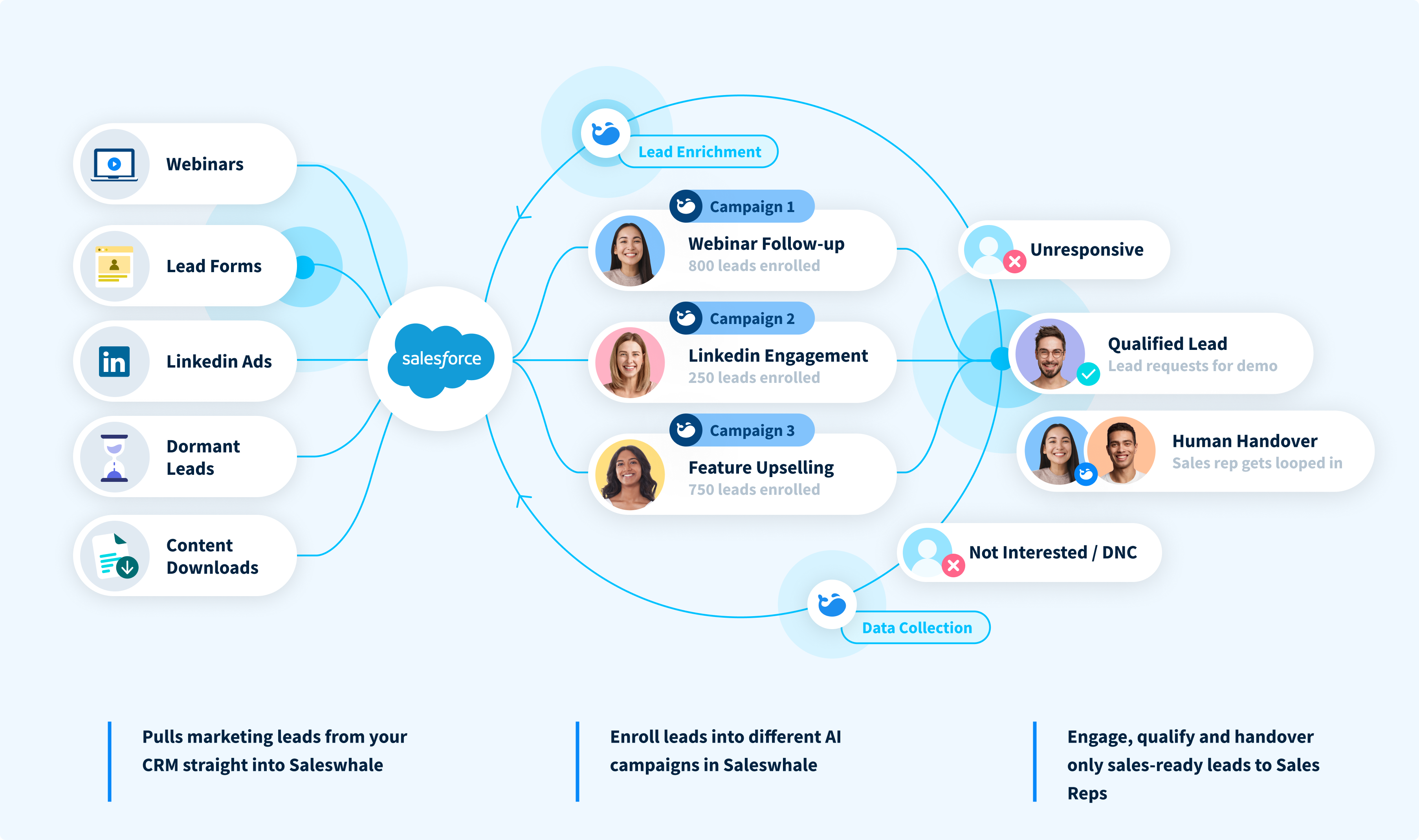Saleswhale Blog | 6 Min Read

Is it possible for a bot to manage email conversations as well as a human? For Saleswhale co-founder and VP of product Venus Wong, the genesis of this question goes back to 2014. She and her co-founder Gabriel Lim were running their previous business, an software consultancy firm.
Eventually, they grew it to a point where they had to manage a team of sales representatives. No mean feat for a couple of young founders who came from software engineering backgrounds! The biggest problem they faced: getting their sales team to engage and qualify leads in a consistent and systematic manner.
“So we decided to build a Gmail plugin that scanned our team members’ inboxes, and looked for certain call-to-action or interrogative words from our customers,” Venus recalled. “If the email goes un-replied for more than two or three days, the plugin would ping us, and the sales reps to follow up. The plugin would also give sales reps recommendations on how to respond to certain questions using relevant collateral.
She confirmed that their sales reps had full knowledge of this, and it ended up working quite well for their team. In fact, when the duo shared their little “experiment” with clients, they were more interested in the plugin than the service that Venus and Gabriel were trying to sell.
This led them to wonder: what if they could create a bot that could do more than send reminders or make suggestions? Was it possible for a bot to completely take over the menial follow up work that sales reps had to do?
“Instead of trying to get a human to change his or her behaviour, why not automate these tasks?” Venus recalled thinking. “After all, a bot will never forget to follow up.”
With this idea, Venus, Gabriel, and co-founder and CTO Ethan Le founded Saleswhale. In 2016, they applied and got accepted into Y Combinator.

(From left to right): Venus Wong, Gabriel Lim, and Ethan Le, of Saleswhale
The trio got down to work fast.“We wanted to create a bot that could manage and qualify leads efficiently and effectively, so that sales reps could focus on more impactful work,” said Venus.
However, there were some assumptions that they needed to test and validate. The biggest one: would companies allow them to “spin up a virtual AI team member on their behalf”?
This was practically unheard of in large companies. Handling human employees is a mammoth task in itself for human resources teams. No one was prepared to manage any difficulties that might crop up with AI employees.
The team worked round-the-clock to get on as many calls as possible with managers from big companies. It helped that Saleswhale got featured on TechCrunch, resulting in hundreds of conversations taking place in the next one to two months.
Finally, they had a working Minimum Viable Product (MVP) to get feedback on—a bot with a considerable amount of features built in already. The Saleswhale AI sales assistant was born.
“When it comes to the MVP, B2B products are quite different from B2C. They need to be a lot more solid from the start,” Venus explained. “B2B products usually involve business process change for companies, and it affects their workflow and productivity - so they have higher expectations.”
Interested in using AI to get more sales-ready leads? Request a demo of our AI sales assistant today!
There were two big challenges the team needed to overcome on the product front.
The first was building a repository of topics for the bot to refer to when conversing with potential leads. In other words, the topic builder.
“A big draw of our software is our bot’s ability to have a two-way conversation with the lead. That is akin to mimicking a human conversation—if your lead says A, the bot should be able to reply B based on the context,” explained Venus.
“But human conversations are so fluid. If I say something, the human on the other end will likely understand the context, and give a reply that makes sense. How can we build something as complex as that into an interface, based on certain heuristics?”
What the founders did was to bring in senior product designer Andrew Abogado, and run a week-long design sprint with him. Everyone in the team helped out wherever they could.
The result was a conversation flow “that looked like a decision tree,” recalled Venus. It looked something like this:

What the topic builder looks like
The other big challenge was collecting a sufficient amount of data to train their “machine learning model.”
Back then, Saleswhale’s main competitor, Conversica was fully AI-based. Their AI was only able to reply to leads based on templates, so their customers were unable to tweak the messaging.
The Saleswhale founders wanted to offer customers more customizability in their conversations. However, this meant that the bot required a human helping hand at the start.
“We came up with a hybrid AI-human model that we coined ‘human in the loop’,” said Venus. This active learning approach involved hiring team members to manually annotate the data that was coming in. In other words, “guide” the bot based on their understanding of how a human sales rep would respond in a particular scenario.
“We would also get the bot to indicate what reply it might give to an email. If the bot’s response differed from the human’s, we would flag it internally,” she said.
By this time, it was clear to the team that a hybrid model would work better than a full-on AI solution if they wanted to build a bot that could manage conversations like a human would.
“To be honest, there are plenty of approaches to choose from when it comes to creating an AI-powered interface. But whether it performs well or not depends on how much relevant, domain-specific structured data you can get. The more data you have, the higher your rate of accuracy” said Venus.
Even the team at well-funded AI scheduling bot x.ai—who plunged a cool US$40 million over four years into research and development—relied on a pool of humans working behind the scenes to annotate data as well, she revealed.
In the early days, the product was priced at US$99 per month—extremely affordable, given its promise to manage leads for clients. Today, a Saleswhale subscription costs much more.
A big reason for this is that more enterprise customers signed on. Therefore, the product had to adapt accordingly. Besides handling load on a larger scale, the bot also had to learn how to hold B2B conversations in a smart manner. This was something the team found out with one of their biggest clients, HR consulting firm Randstad.
“As it turned out, there were many nuances that we hadn’t considered in business-focused conversations,” Venus recalled.
“For instance, when it came to account-based selling, salespeople from Randstad might reach out to different people within the same company, and all get referred to the head of HR. So four email threads would get started with that one person—not a good look.”
The team spent most of 2018 improving the bot’s B2B conversation capabilities. New features were added, like the ability to intelligently terminate multiple conversations with the same person and bring them all into one thread, and the ability to attach relevant documents.
More enterprise-level features are in the works, such as the ability to handle multiple bots per account and allowing clients to run account-based campaigns.
“We’re also looking into conversation-related features such as expanding the number of languages we support, and other channels besides emails like SMS or voice calls. These would allow our customers to run omni-channel campaigns” Venus revealed.
From a simple plugin that reminded salespeople to follow up, to an AI sales assistant that serves global clients like Randstad Group, Zendesk and General Assembly - Saleswhale’s bot has came a long way and it’ll be exciting to see how it’ll continue to evolve!
Interested in using AI to get more sales-ready leads? Request a demo of our AI sales assistant today!
Originally published on 30 November 2018, updated on 18 December 2019

Sign up for cutting edge ideas on conversational marketing, AI assistants and martech.

Saleswhale for Salesforce allows you to build powerful automated lead conversion workflows. This allows you to re-engage with your neglected marketing leads at...
19 APR 2021

Demand generation and marketing teams generate more leads at the top of the funnel than ever in this new digital-first world. Saleswhale helps ensure those...
1 MAR 2021

Marketers that focus on MQLs end up doing the wrong things in order to achieve the metrics. So I changed it.
16 JUN 2020

Conversica isn't the only player out there. Learn how Saleswhale and Exceed.ai compare and make an informed decision.
15 APR 2021
By providing your email you consent to allow Saleswhale to store and process the personal information submitted above to provide you the content requested.
You can unsubscribe at any time by clicking the link in the footer of our emails. For information about our privacy practices, please visit our privacy page.